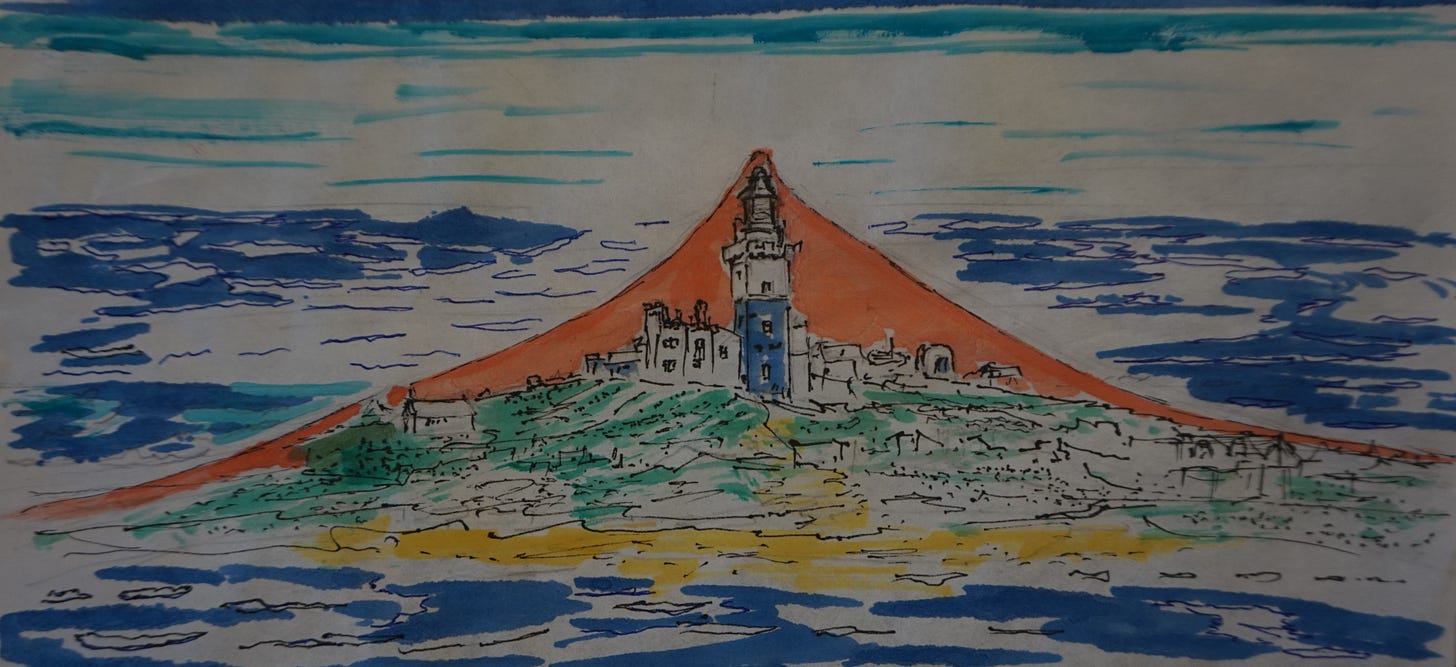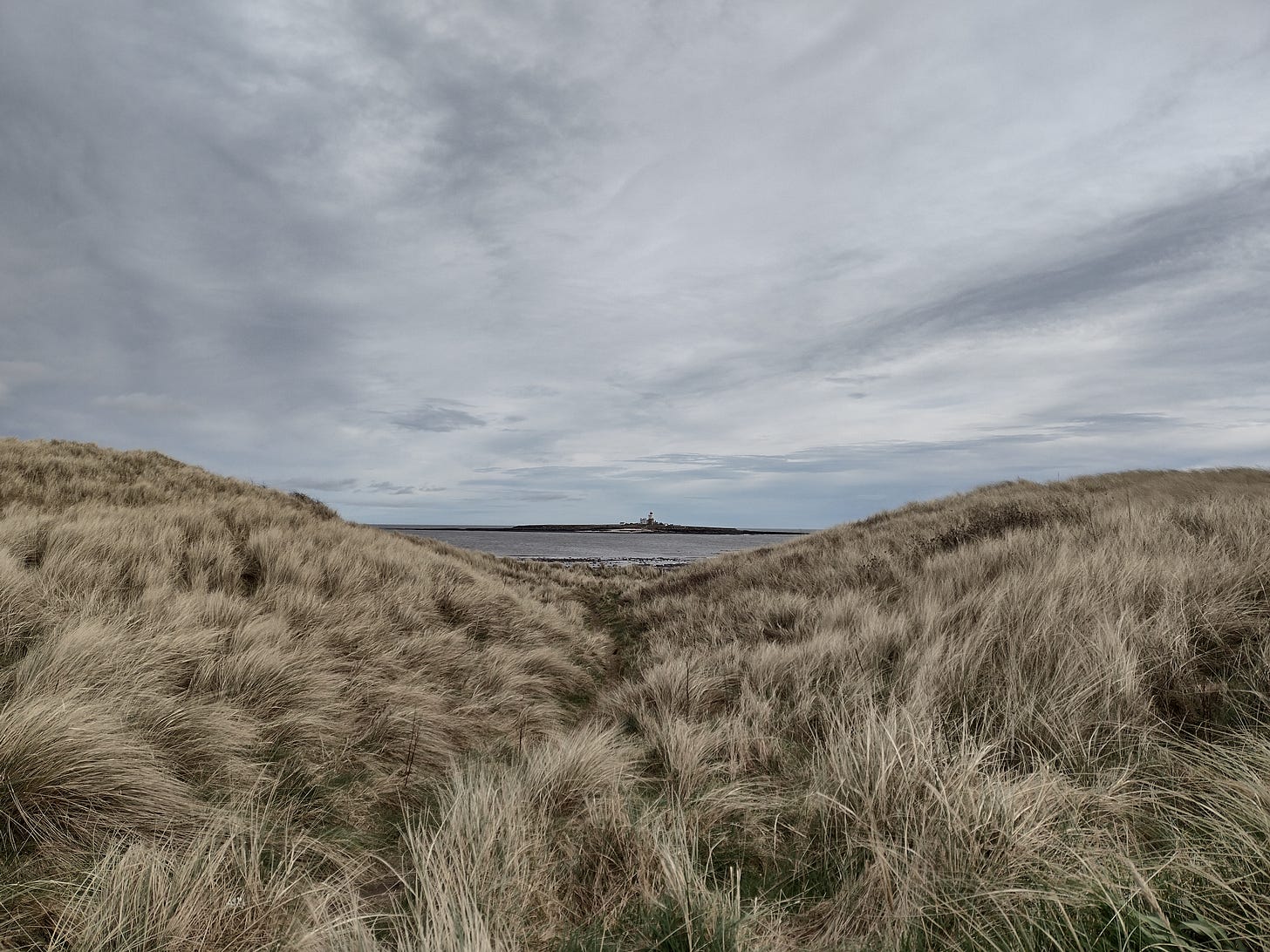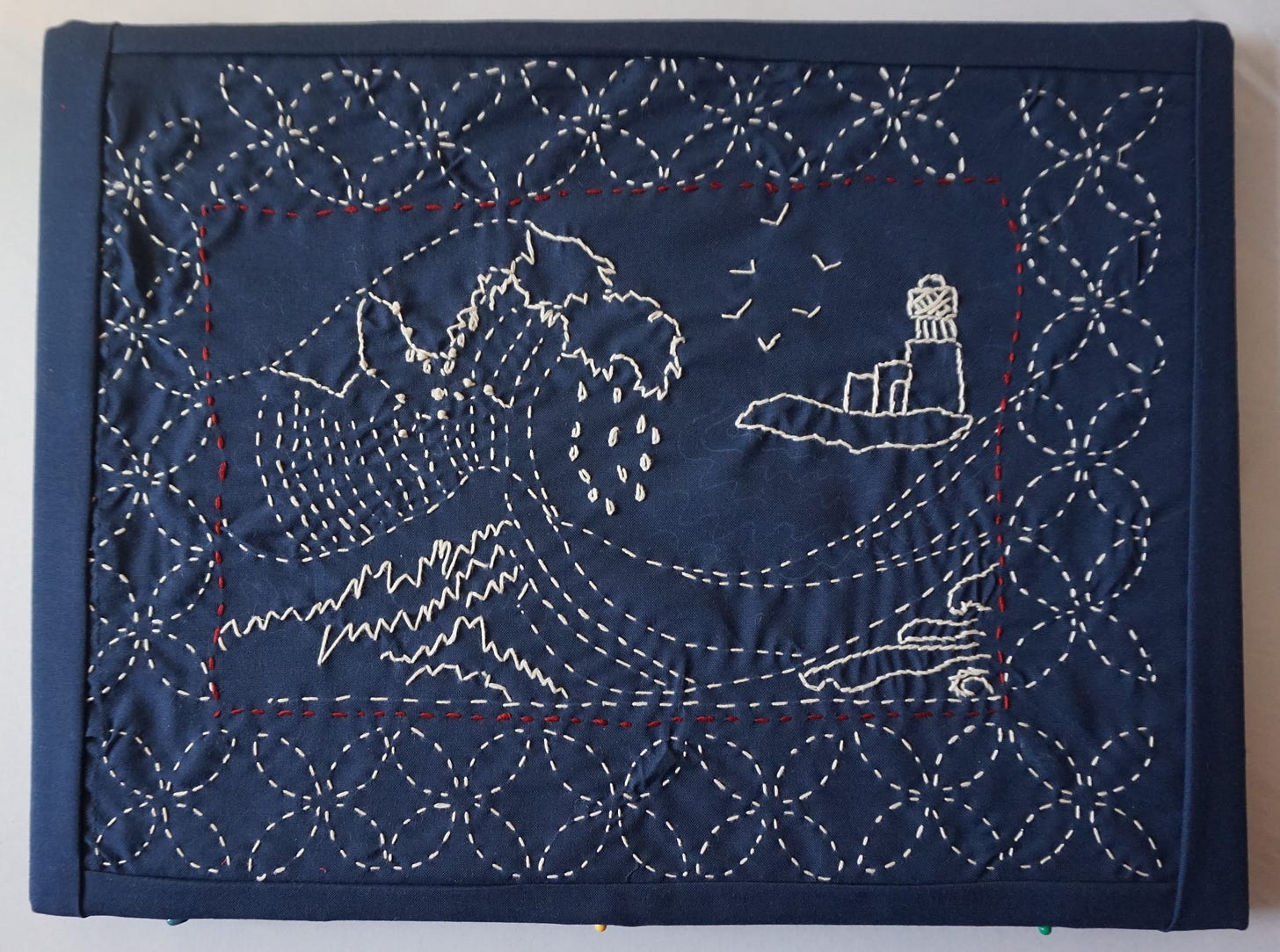View Thirteen: Larraine Duquemin and her painting Under Mount Fuji
Larraine painted this eye-catching view of Coquet and Fuji together, using watercolour and pen and ink on rice paper.
Larraine’s website is here and she can also be found on Instagram here.
View Fourteen: Jim Donnelly and a Coquet Island haiku
In this haiku, Jim sees another of the island’s moods.
Riding white horses Along a haunted shoreline In a windswept bay
You can find more of Jim’s work at his website here.
View Fifteen: Ali Rowland and Flockham Sisby with their movie Phantoms Ancient & Modern
In this atmospheric and downright spooky movie, poet Ali and sound artist Flockham investigate the phantoms of Coquet Island.
There’s more of Flockham’s work on Facebook and Ali’s Facebook page is here.
View Sixteen: Phil Griffin and Echoes of Coquet Island
In which Phil tells the story of a dog-walking encounter and an unexpectedly eerie sound.
I was walking my dog, Lucky, one morning along the stretch of beach that connects Hauxley to Amble, when I struck-up a conversation with a fellow dog walker, an elderly chap, local born and bred, and very friendly.
Midway through our chat, he suddenly raised his hand to command a pause, before leaning forward and hissing in a low conspiratorial whisper, “D’ya hear that?”
I listened and was surprised to find that I could, indeed, hear something . . . something very strange . . . a sort of medium-pitched whine, slightly oscillating, rising and fading in uneven waves . . . and coming from somewhere that was somehow nearby yet at the same time . . . far, far away.
“What is that?” I eventually uttered, finding myself both mystified by the sound and, for some reason, oddly annoyed. “What IS that?”
The old man pointed straight at Coquet Island, which lay tantalisingly beyond reach across the shallow water of a low tide. “It’s the seals – dozens of ’em. From time to time, they gather on the rocks, on the far side of the island. You can never see ’em, but sometimes—just sometimes, mind, if you’re very lucky, conditions are right, and the wind is working for you . . . you can hear ’em – just like today.”
“Oh, I see-eee. So, it’s seals, eh? That’s what I can hear.” I laughed.
“I know a place – a special place – where their calls sound even more eerie, echo overlapping echo . . . like a movie sound effect . . . the lost souls of the dead.”
“Oh, really?” I replied, struggling to disguise my caution. “Where’s that then?”
“See that deep dip in the dunes back there?”
About fifty yards away – over his shoulder, and in the direction I was heading – sure enough, I could clearly see the feature he was referring to. “Do you mean where the grass comes down to the beach?”
“Yes, that’s right, just above the tide line.”
“Okay. It looks like an easy place to climb up into the dunes.”
“Oh, it is—it’s dead easy. Take the path going away from you and stop just before it joins the path that runs along the back of the dunes; you’ll be no more than thirty yards or so away from the beach. Then, when you get there, just turn round . . . and listen.”
He smiled. “You won’t be disappointed.”
I thanked him. We separated. I did as instructed. I exited the beach at the easy access point of the dip in the dunes. I made my way to a place near the top of the path and turned, and . . . as a brisk onshore breeze – no doubt funnelled by the dip itself – flicked-up my hair . . . I listened.
The old man (who I’ve yet to meet again) was right . . . I wasn’t disappointed.
You can find more of Phil’s writing, under his pen name PP Leonard, here.
View Seventeen: Denise Howe and her Coquet in Sashiko
Denise explains:
Sashiko literally means 'little stabs' and is a type of traditional Japanese embroidery or stitching used for the decorative and/or functional reinforcement of cloth and clothing.
I have used this technique, taking inspiration from a famous Hokusai print (The Great Wave off Kanagawa) with our view of Coquet Island, instead of Mount Fuji, from the pier on a stormy day - using traditional Japanese Indigo dyed fabrics (Indigo is registered in Japan as a National Treasure).
In emphasising the merging of two cultures and techniques, I have deliberately added knots to the design (French Knot stitches to embellish the ‘froth’ from the waves)- but have bordered the design with a traditional sashiko ‘wave’ pattern – and used the running ‘rice grain’ stitch to emphasise the shape of the stormy waves.
In his 1824 New Forms for Design, Katsushika Hokusai inspired many sashiko patterns.
You can find Denise on Linked In here and on Pinterest here.
View Eighteen: from The Journal October 9, 1841
At sunset yesterday week the light was exhibited for the first time on the Coquet Island. It is a brilliant fixed light, and will be seen from a great distance at sea. Several parties made excursions during the day to the island and in the evening the Warkworth Steamer took a party off to sea to witness its effect.
From the rocks being buoyed and the island lighted, this place, instead of being a terror to mariners, will now be a protection and refuge to them in gales of wind from east to all points round to the south and west.
It has been a pleasure to exhibit six more views this week. We hope you are enjoying them. Another six will follow next weekend. If you haven’t already subscribed, please consider doing so (it’s free!) and share this artistic collaboration with others.








I’m enjoying this series Allan. It’s lovely to see work from our writing group featured too. A very interesting mix of creative viewpoints.
Thank you for including “Phantoms ….” - we hope nobody is too scared by them! This series is unearthing so many and varied pieces of art, and so many talented Amblers.